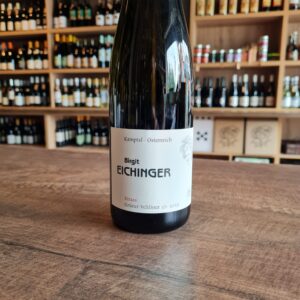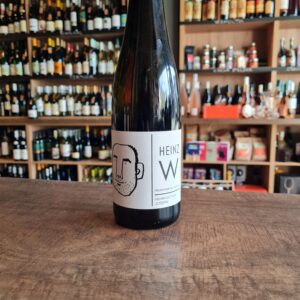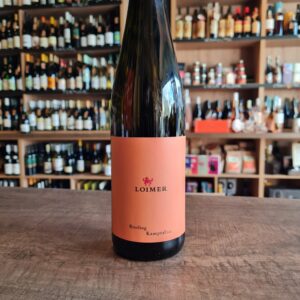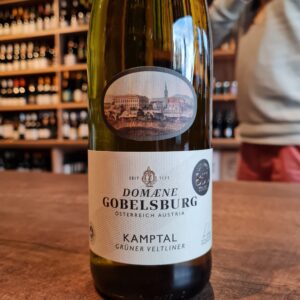Kamptal – Austria
-
 Weingut Birgit Eichinger was founded in 1992 by Birgit Eichinger and her husband Christian, who started out with roughly nine acres of vineyards shed from her parents' business, over time the vineyard area was expanded to 23 acres in the best traditional sites of Strass. This is a single-vineyard Grüner, from a vineyard whose loess (loose and sandy) soils and southward face are perfect for the cultivation of traditional Kamptal-style Grüner. The Birgit Eichinger Grüner Veltliner Strass Kamptal impresses with its elegantly dry taste. It was put on the bottle with only 1.8 grams of residual sugar. As one can of course expect with a wine, this Austrian naturally enchants with the finest balance in all dryness. Taste doesn't necessarily need sugar. On the palate, the texture of this light-footed white wine is wonderfully light. Due to the balanced fruit acidity, the Grüner Veltliner Rhinestone Kamptal flatters with velvety mouthfeel, without missing out on juicy liveliness. The finish comes with mineral notes of the soils dominated by loess soil and sandstone.
Weingut Birgit Eichinger was founded in 1992 by Birgit Eichinger and her husband Christian, who started out with roughly nine acres of vineyards shed from her parents' business, over time the vineyard area was expanded to 23 acres in the best traditional sites of Strass. This is a single-vineyard Grüner, from a vineyard whose loess (loose and sandy) soils and southward face are perfect for the cultivation of traditional Kamptal-style Grüner. The Birgit Eichinger Grüner Veltliner Strass Kamptal impresses with its elegantly dry taste. It was put on the bottle with only 1.8 grams of residual sugar. As one can of course expect with a wine, this Austrian naturally enchants with the finest balance in all dryness. Taste doesn't necessarily need sugar. On the palate, the texture of this light-footed white wine is wonderfully light. Due to the balanced fruit acidity, the Grüner Veltliner Rhinestone Kamptal flatters with velvety mouthfeel, without missing out on juicy liveliness. The finish comes with mineral notes of the soils dominated by loess soil and sandstone. -
 Grüner Veltliner is Austria's most famous grape variety and is considered Austria's national grape variety. The best Grüner Veltliner wines come from the northeast of the country, especially regions such as the Wachau, Kamptal and Kremstal bordering the Danube River. This wine made by Weingut Weixelbaum the winery of Heinz and Gabi Weixelbaum. Located in the village of Strasser in the Austrian Kamptal. It is a medium sized, typical Austrian winery. A family business that is passed on from generation to generation. Heinz Weixelbaum has very good vineyards on soils of 'urgestein' and 'loess', Heinz also dares to prune a lot in the spring, so that his wines are more powerful than most from the region. The Weixelbaum family only makes wine from grapes from its own 22 hectares of vineyards. Everything is done by hand and the cellar is full of the most modern equipment. The vineyards in the Kamptal owe their name to the river Kamp that flows through the area. It is one of the most prestigious Austrian wine districts. In this wine-growing region, which is part of the federal state of Lower Austria, warm and sunny summer days ensure optimal ripening of the grapes. In addition, a cooling breeze during the night guarantees flawless aromas and refined acids in the wines. The vineyards are mainly terraced along the steep banks of the river. The soil consists largely of loess, loam, gravel, sandstone and shale. Because the roots of the vines can reach up to six meters deep, the wines get a different character on every surface.
Grüner Veltliner is Austria's most famous grape variety and is considered Austria's national grape variety. The best Grüner Veltliner wines come from the northeast of the country, especially regions such as the Wachau, Kamptal and Kremstal bordering the Danube River. This wine made by Weingut Weixelbaum the winery of Heinz and Gabi Weixelbaum. Located in the village of Strasser in the Austrian Kamptal. It is a medium sized, typical Austrian winery. A family business that is passed on from generation to generation. Heinz Weixelbaum has very good vineyards on soils of 'urgestein' and 'loess', Heinz also dares to prune a lot in the spring, so that his wines are more powerful than most from the region. The Weixelbaum family only makes wine from grapes from its own 22 hectares of vineyards. Everything is done by hand and the cellar is full of the most modern equipment. The vineyards in the Kamptal owe their name to the river Kamp that flows through the area. It is one of the most prestigious Austrian wine districts. In this wine-growing region, which is part of the federal state of Lower Austria, warm and sunny summer days ensure optimal ripening of the grapes. In addition, a cooling breeze during the night guarantees flawless aromas and refined acids in the wines. The vineyards are mainly terraced along the steep banks of the river. The soil consists largely of loess, loam, gravel, sandstone and shale. Because the roots of the vines can reach up to six meters deep, the wines get a different character on every surface. -
 The Loimer estate is located around Langenlois in the sunny Kamptal region of Lower Austria, to the northwest of Vienna. Unlike many Austrian producers who go for a rich, sweet Alsace style, Fred Loimer obtains full ripeness in the vineyard yet ferments to dryness. The resulting wines (like the Loimer Riesling) display his trademark definition, zest and balance on the palate. Fred Loimer realised very early on that his future lay in wine, after his father converted the family farm into a winery. He attended Austria’s renowned Klosterneuburg University and later gained important experience at wineries in Nahe, Germany and in Napa Valley, California. On his return to Langenlois, Fred introduced new methods in the vineyards and winery, with the aim of continually improving the quality of the wine. In 1997, Fred took over the winery from his father and, in 1998, purchased and renovated a historical vaulted brick cellar (a former cellar of the Haindorf Castle) amidst the vines between Langenlois and Zöbing. The wines have been vinified and stored here since 1999. The 60 hectares of vineyards are divided into 100 parcels, planted on seven different soil types (ranging from loess, gravel, clay, sand and slate to Gföhler gneiss, a coarse-grained, metamorphic rock containing quartz, felspar and mica), which bring great complexity to the wines. There is no need to say that the high quality of their soils is crucial for the Loimer Riesling and its minerality. Situated at an altitude of 200-420m above sea level, the south facing vineyards benefit from warm days and cool nights, which encourage the development of the aromatic components in the grapes. The high summer temperatures are mitigated by the River Danube and the Waldviertel (forested area), while the well drained soils mean the vines can form deeply penetrating root systems, thus overcoming even long periods of drought without damage. Since 2006, the vineyard and cellar work has been conducted according to biodynamic principles.
The Loimer estate is located around Langenlois in the sunny Kamptal region of Lower Austria, to the northwest of Vienna. Unlike many Austrian producers who go for a rich, sweet Alsace style, Fred Loimer obtains full ripeness in the vineyard yet ferments to dryness. The resulting wines (like the Loimer Riesling) display his trademark definition, zest and balance on the palate. Fred Loimer realised very early on that his future lay in wine, after his father converted the family farm into a winery. He attended Austria’s renowned Klosterneuburg University and later gained important experience at wineries in Nahe, Germany and in Napa Valley, California. On his return to Langenlois, Fred introduced new methods in the vineyards and winery, with the aim of continually improving the quality of the wine. In 1997, Fred took over the winery from his father and, in 1998, purchased and renovated a historical vaulted brick cellar (a former cellar of the Haindorf Castle) amidst the vines between Langenlois and Zöbing. The wines have been vinified and stored here since 1999. The 60 hectares of vineyards are divided into 100 parcels, planted on seven different soil types (ranging from loess, gravel, clay, sand and slate to Gföhler gneiss, a coarse-grained, metamorphic rock containing quartz, felspar and mica), which bring great complexity to the wines. There is no need to say that the high quality of their soils is crucial for the Loimer Riesling and its minerality. Situated at an altitude of 200-420m above sea level, the south facing vineyards benefit from warm days and cool nights, which encourage the development of the aromatic components in the grapes. The high summer temperatures are mitigated by the River Danube and the Waldviertel (forested area), while the well drained soils mean the vines can form deeply penetrating root systems, thus overcoming even long periods of drought without damage. Since 2006, the vineyard and cellar work has been conducted according to biodynamic principles. -
 Like every vintage, the Grüner Veltliner Domain Gobelsburg is the benchmark wine in this price range, balanced, juicy and delicate, that's how Veltliner is fun. Delicate spice on the nose with some Boskop apple, Williams pear and herbaceous hints of thyme and mint. On the palate a rather soft texture, gentle fruit with a nice acidic accompaniment, delicately piquant pepper, then some minerality comes through. Again one of the most harmonious entry-level Veltliners of this vintage!
Like every vintage, the Grüner Veltliner Domain Gobelsburg is the benchmark wine in this price range, balanced, juicy and delicate, that's how Veltliner is fun. Delicate spice on the nose with some Boskop apple, Williams pear and herbaceous hints of thyme and mint. On the palate a rather soft texture, gentle fruit with a nice acidic accompaniment, delicately piquant pepper, then some minerality comes through. Again one of the most harmonious entry-level Veltliners of this vintage!

